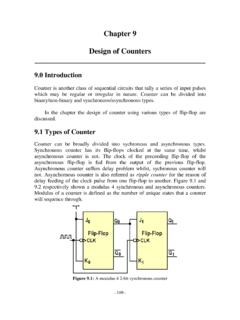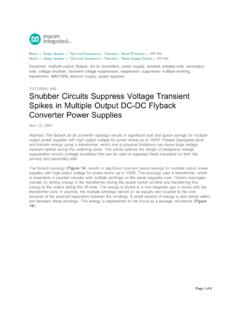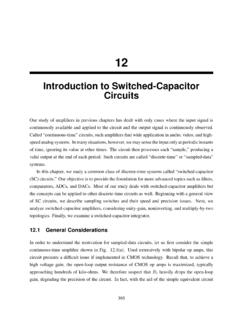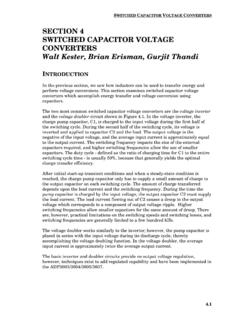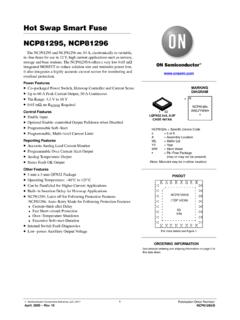Transcription of Chapter 16 Oscillator Circuits and Applications
1 - 441 - Chapter 16 Oscillator Circuits and Applications _____ Introduction Oscillator contains circuit that generates an output signal without necessity of an input signal. It is a circuit that produces a repetitive waveform on its output with only dc supply as input. The Oscillator can be sinusoidal or non-sinusoidal type. They can be used in many Applications such as communication and digital system. Oscillator operation is based on positive feedback whereby portion of the output signal Vout is feedback without phase change. This shall mean that there is no phase difference between the input and feedback signal. Many Oscillator Circuits can be designed using operational amplifier circuit. It can generate various types of waveform with no input other than dc supply. These are known as signal generators or oscillators. Principles of Oscillator With exception such as relaxation Oscillator , the operation of Oscillator is based on principle of positive feedback where portion of the output signal is feedback into input without phase change.
2 Thus, it reinforces the input and sustains the continuous sinusoidal output. Beside this, the phase shift of feedback signal must be either 0o or 360o. The last requirement is the loop gain T of amplifier must be equal to one, which is also named as Barkhausen criterion. Thus mathematically, the loop gain T is T =AV = 1 ( ) where AV is the voltage gain of the amplifier and = VVoutf is the feedback portion of output voltage. If AV is equal to 10 then the feedback portion should be 1/10. The principles of the Oscillator are illustrated in Fig. The transfer function of the circuit shall be Af = VVA1A. 16 Oscillator Circuits and Applications - 442 - Figure : Principle of sinusoidal Oscillator Non Sinusoidal Oscillator Triangular wave, square wave, and waveform from voltage controlled Oscillator VCO are examples of non-sinusoidal waveforms. Generally, they can be designed using operational amplifier, resistor, and capacitor.
3 Triangular Wave Oscillator A basic triangular wave generator is shown in Fig. and its waveform is shown in Fig. When the switch is at position 1, which is at negative voltage, the output of the operational amplifier will ramp from negative to positive voltage. Likewise, when the switch is at position 2, which is at positive voltage, the output of the op-amp will ramp from positive to negative voltage. Figure : A basic triangular waveform generator 16 Oscillator Circuits and Applications - 443 - The waveform of the basic triangular waveform is shown in Fig. , which is derived from integrator Vout = )0t(VVdtRC1 Ctt21=+ , where Vc(t = 0) is the voltage of capacitor at time t = 0. Figure : The basic principle of a triangular wave generator A practical triangular wave generator is shown in Fig. whereby its positive and negative peak voltage and period can be specified. Figure : A practical triangular wave generator The peak-to-peak output voltage Vout(PP) is, Vout(PP) = VUTP -VLTP ( ) where VUTP = )V(RR(max)out23+ and VLTP = )V(RR(max)out23.
4 +Vout(max) and -Vout(max) are the positive and negative output swing of the comparator. The resonant frequency fr of this triangular wave is 16 Oscillator Circuits and Applications - 444 - fr = 321 RRCR41 ( ) Based on equation ( ), by varying the value of resistor R1 will change the frequency of the Oscillator but not the peak-to-peak voltage, which is governed by equation ( ). Saw tooth Wave Oscillator A saw tooth wave generator utilizes the concept of voltage-controlled Oscillator VCO. It can be designed by using a programmable unijunction transistor PUT and an operational amplifier integrator arranged as shown in Fig. Figure : A saw tooth wave generator circuit using PUT A negative input voltage Vin is used to establish a positive ramping voltage whereby at this stage the capacitor C is charging and the output Vout is ramping up. As soon as the output voltage reaches the programmed voltage VP of programmable unijunction transistor PUT plus the forward voltage VF of the diode, which is , the PUT is conducting causing the capacitor to discharge and output voltage drop abruptly to the forward voltage VF of the programmable unijunction transistor PUT.
5 The period T of the wave is T = RCVVVinFP ( ) 16 Oscillator Circuits and Applications - 445 - where |Vin|RC is ramping rate of output voltage. Saw tooth wave can also be designed using the triangle wave circuit with inclusion of reference voltage Vref at the non-inverting input pin of the integrating operational amplifier. The circuit of the design is shown in Fig. Figure : A saw tooth wave generator circuit design using square wave circuit R4 is the potentiometer that is used to provide Vref voltage to the integrator. By control Vref voltage, shape of the saw tooth wave can be varied. The time t1 of the positive ramping of the wave is t1 = ()()(max)out23ref(max)out1 VRRVVCR2+ +. The time t2 for the negative ramping of the wave is t2 = ()()(max)out23ref(max)out1 VRRVVCR2 + . If we assume that the saturation voltages of the operational amplifier is the same. (+Vout(max)) = (-Vout(max)) = Vout(max), then the period T of the saw tooth wave is equal to T = 232ref2(max)out2(max)out1 RRV)V()V(CR4 ( ) The duty cycle of the saw tooth wave is equal to t1/T = ()()(max)out23ref(max)out1 VRRVVCR2 322(max)out12ref2(max)outRR)V(CR4V)V( = +(max)outrefVV121.
6 Fixing duty cycle and knowing Vout(max), Vref can be known and adjusted using R4. 16 Oscillator Circuits and Applications - 446 - Square Wave Oscillator The square wave Oscillator is designed based on the principle of charging and discharge of the capacitor and comparator, which is shown in Fig. Figure : Square wave Oscillator When the circuit is turned on, the voltage at inverting input is zero. Thus, the output of the op-amp is swung to maximum positive value, which should be the positive saturation voltage of the operational amplifier. The capacitor begins to charge until the voltage VC is just greater than the feedback voltage Vf, which is out323 VRRR+. At this point, the output of the op-amp is swung to minimum negative value, which is the negative saturation voltage of the op-amp. This would cause the capacitor to discharge . When the voltage VC reaches negative Vf, the output of op-amp swings to positive again.
7 This process repeats and generates square wave. The period T of the oscillation can be shown to follow equation ( ). T = 2R1C1ln(1 + 2R3/R2) ( ) It can be calculated using charging equation VC1 = Vout + (-Vf Vout)exp(-t/R1C1) for VC1 = Vf and discharging equation VC1 = - Vout + (Vf + Vout)exp(-t/R1C1) for VC1 = - Vf. If the value of resistor R2 is R2 = , then the period T is T = 2R1C1. 16 Oscillator Circuits and Applications - 447 - Oscillators with RC Feedback Circuit Many oscillators are designed utilizing RC network and resistor divider Circuits . RC network is basically used to determine the resonant frequency of the Oscillator , whilst resistor divider circuit is used to provide attenuated feedback. Generally Oscillator with RC network can provide frequency not more than 1 MHz. For Oscillator that can provide frequency more than 1 MHz, LC network is used. Wien-Bridge Oscillator Wien-Bridge Oscillator is an Oscillator that meets the principle of Oscillator .
8 Its circuit is shown in Fig. Figure : Wien-Bridge Oscillator There is a lead-lag RC network whereby C1 and R3 leads and R4 and C2 lags. Reactance C1 of capacitance C1 is significantly affecting the VIN+ at low frequency, whilst reactance C2of capacitor C2 equal to 2C1 /j is significant affecting at high frequency. If C1 = C2 and R4 = R3, there will be no phase-shift because the phase lead is compensated by phase lag. From the analysis of the circuit, the portion of the output feedback to input = outVVfshall be 16 Oscillator Circuits and Applications - 448 - = VVoutf= jj RCRCR C31222+ () ( ) Applying Barkhausen principle of Oscillator design this shall mean that overall loop gain A =jj RCRCR C31222+ ()AV = 1. From real part and imaginary part of the complex number solution, the resonant frequency fr of the Oscillator shall be fr = RC21 ( ) The voltage gain AV of the amplifier should be 3. This shall mean that feedback portion is 1/3.
9 Since the voltage gain of the amplifier AV should be 3, this shall mean that AV = 221 RRR+= 3 ( ) In order for Wien-Bridge Oscillator to start oscillating, the initial voltage gain AV should be slightly more than three. Adding an extra circuit, which is called stability circuit as shown in Fig. , will provide self-start and sustain the oscillation. Figure : Self-starting and sustaining Wien-Bridge Oscillator 16 Oscillator Circuits and Applications - 449 - Before zener diode D1 and D2 conduct, the voltage gain AV of the amplifier is AV = RRRRR12252++= 25RR3+ ( ) Thus, it meets the conditions of closed loop gain greater than 1 for self-starting of the Oscillator . When the output voltage reaches the zener breakdown voltage plus , the zener diode conducts. Its forward resistance would be much smaller than the resistance value of resistor R5. Thus, the closed loop gain will be back to 1 and oscillation would be sustained.
10 Operational Amplifier Phase-Shift Oscillator The operational amplifier phase-shift Oscillator is another Oscillator type that meets the principles of Oscillator design. Its circuit is shown in Fig. Figure : Operational amplifier phase-shift Oscillator The feedback portion of the Oscillator can be derived by applying Kirchhoff s current law at node a and node b respectively. Current i1 is i1 = sRC1sCVb+, i2 = RVb, 16 Oscillator Circuits and Applications - 450 - i3 = (Va Vb)sC, i4 = RVa, and i5 = (Vout Va)sC. Voltage at node b is also equal to Vb = fVsRCsRC1 +. At node b, current i3 = i1 + i2; RVsRC1sCVsC)VV(bbba++= . This implies that Va = +++1sRc1sRC11Vb. At node a, i5 = i1 +i2 +i4; RVRVsRC1sCVsC)VV(abbaout+++= . This implies that sCVRVRVsRC1sCVsCVaabbout++++=. Substituting the expression of Va and Vb into the above equation yields equation ( ), which is the feedback portion . = VVoutf= 1RC5CR6 CRCR222233333333+ + + jjjj ( ) After applying Barkhausen principle of Oscillator design, from real part of the complex number denominator, which is (1-6 2R2C2) = 0, the resonant frequency fr of the Oscillator shall be fr = 126 RC ( ) From the imaginary part of the complex number, which is 1RC5 CRACR3333V3333= + jjj, the voltage gain AV of the amplifier shall be AV = 15222 RC ( ) From equation ( ), this shall mean that 22216=RC.

